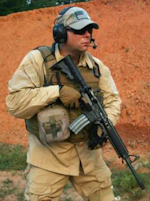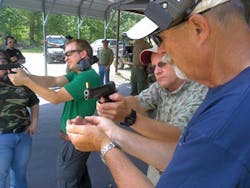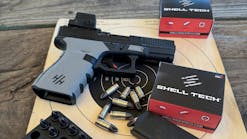Dry Fire: The Practice for Pros, Not Just Beginners
Many moons ago, when I was a young Marine and Ronald Reagan was my Commander-in-Chief, I learned one of the most valuable training tools for firearms mastery; snapping-in or as the non-Jarheads call it, dry-fire.
Before us young recruits were ever handed a piece of live ammunition on the Parris Island Rifle Range we spent several days learning to “snap-in”. We called this Grass Week, as the vast majority of our time was spent lying, sitting, and kneeling in the grass.
During Grass Week our Primary Marksmanship Instructor ran us through innumerable drills and taught us all about bone-support, natural point of aim, sight picture, sight alignment, trigger press and the meaning of BRASS-F. We snapped-in and dry-fired for literally hours upon hours. I still recall the admonishment of my PMI all these years later. “We aren’t just lying around clicking triggers. Take your dry-fire seriously. Those of you who do will be rewarded on Qual Day.”
Those who are uninitiated have said that this dry-fire technique was used merely as a way for the Marine Corps to save money on ammunition. Others have offered that dry-fire or snapping-in is merely “busy work” meant to eat up time in the day. With a few decades of experience under my belt and thousands of students trained, I can say that the previous assumptions while seductive are far from the mark.
Beginners or Professionals?
Many trainers who accept the concept of dry-fire (firearms practice without ammunition) fall into the trap of thinking that dry-fire is simply a technique for beginners. To that end, many shooters feel that once they’ve demonstrated themselves to be ‘safe’ with a gun they no longer need to dry-fire. The misconception holds that dry-fire is for the beginner and once experience has been gained it is no longer necessary.
Throughout the years I’ve had the opportunity to pick the brains of numerous firearms trainers and professional shooters regarding the most effective ways to train humans to use guns. Of these pro shooters Max Michel and Todd Jarrett come immediately to mind. When considering dry-fire both the aforementioned men, who make their living with a gun in hand, commented that they started their careers with weekly practice routines that included one, two, and sometimes three hours a day of dry-fire, five to six days a week, continuing for several years.
During my career as a Marine and military instructor I’ve spent enough time with Special Operations troops to know that they dry-fire and rehearse religiously. One SF troop put it bluntly to me, “…the difference between a good shooter and a great shooter is how much dry-fire they do.”
Get the most out of Dry-Fire
If you are willing to accept that dry-fire is a valid form of practice and not just something for beginners, the next step is to address how to do so properly. It is true that dry-fire training can be about much fun as watching paint dry or grass grow, take your pick. Because of the redundancy factor, far too often what could be a valuable practice routine becomes an exercise in trigger clicking.
The trick to dry-fire, if you will, is to hold the gun and press the trigger exactly as you would if there was live ammunition in the chamber and you are expecting a ‘bang’. We all have good days and bad days, but effective and worthwhile dry practice requires mental discipline. Any knucklehead can point a gun as a wall and snap the trigger. That’s not dry practice.
It is a lack of mental discipline and the trigger snapping routine that has driven many instructors away from recommending dry practice. Thoughtless trigger snapping can lead to what many call “training scars” or bad habits that actually detract from good marksmanship.
While it may seem strange, the best way to learn how to dry-fire is under the watchful eye of a professional instructor. Without an instructor’s critique you may simply be ingraining bad habits.
If you have a partner or friend, try practicing dry-fire as a team. With your handgun outstretched in a firing positions, have you partner balance a spend casing or a dime on the front sight of you pistol. Try to press the trigger and release the sear without dropping the case or coin. If you can do that ten times in a row without dropping the object you are on your way to an excellent trigger press.
When it comes time to practice presentation from the holster, again you should first do so under the watchful eye of an instructor. During your skill maintenance practice, take your time and go about half speed. The worst thing you can do is try to ‘outdraw’ yourself. Stop worrying about speed and start worrying about technique. Each and every draw stroke or trigger press trains the neuromuscular impulses in your body. Just like a professional golfer or baseball player, you are teaching your body how to perform the action in question. Strive for a perfect draw stroke or perfect trigger press each time.
Safety Note
You know that I can’t close this piece without a safety note. Dry-fire is most often carried out with live, genuine firearms. When you’ve decided to dry practice take the time to remove all live ammunition from your reach. It’s not enough to simply clear the gun. All spare magazines, etc. must be moved away so that you don’t inadvertently grab one should you get distracted. Also, the 4 Universal Safety Rules still apply to dry-fire. Your gun should never be pointed an anything that will bleed but instead index it on something that would actually stop or absorb a bullet should the worst happen.
Dry-fire isn’t just for beginners. It’s for all dedicated students of the gun. Get more training and take your dry practice seriously. If you have the mental discipline and diligence you’ll see the results on your next Qual Day.

Paul Markel
Mr. Markel is a former United States Marine, Police Officer, and has worked as a professional bodyguard both in the U.S. and overseas. A Subject Matter Expert on Small Arms and Tactics, Markel has provided instruction to law enforcement and U.S. Military troops.
As a recognized author and writer, Paul has penned several hundred articles published in numerous professional journals and trade periodicals. Topics include firearms training, use of force, marksmanship, less-than-lethal force options, product reviews and evaluations, emergency medical care, and much more. Sought after as a public speaker, Mr. Markel is at home in front of an audience large or small.
Follow Mr. Markel's instructional show: http://www.studentofthegun.com



